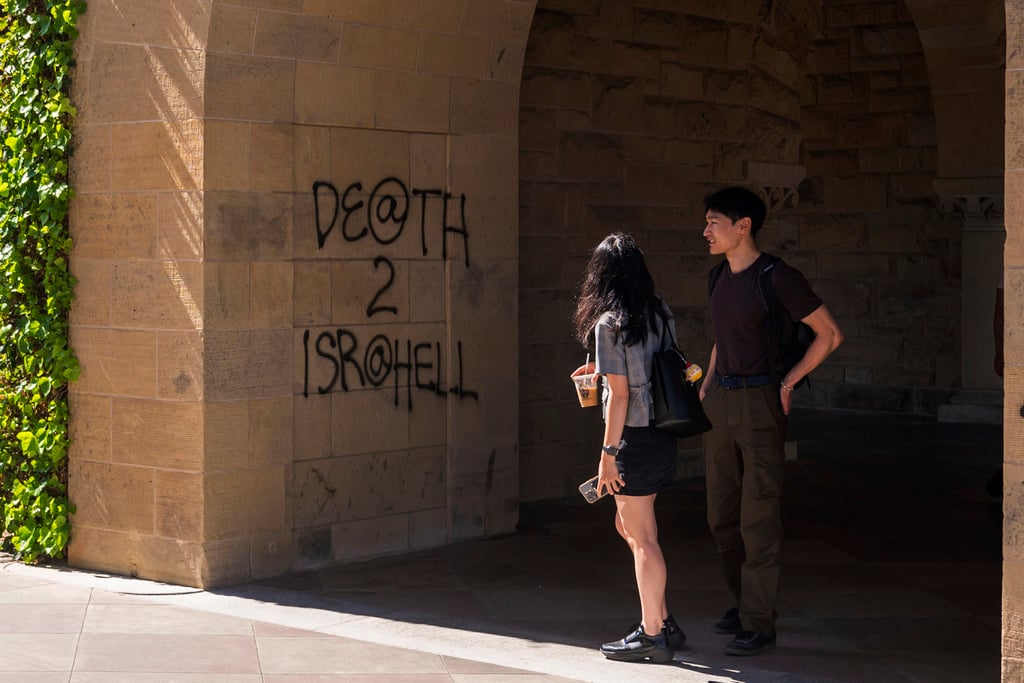The incident was part of a larger pro-Hamas demonstration in which SJP demanded that the university adopt the boycott, divestment, and sanctions (BDS) movement.
By Dion J. Pierre, The Algemeiner
Twelve Stanford University students have been charged with felony vandalism and conspiracy to trespass for their role in the takeover of an administrative building during the final days of the 2023-2024 academic year, the Santa Clara County District Attorney’s Office announced on Thursday.
“Dissent is American. Vandalism is criminal,” District Attorney Jeff Rosen said in a statement.
“There is a bright line between making a point and committing a crime. These defendants crossed the line into criminality when they broke into those offices, barricaded themselves inside, and started a calculated plan of destruction.”
As previously reported by The Algemeiner, on June 5, 2024, pro-Hamas activists associated with the campus group Students for Justice in Palestine (SJP) raided then-president Richard Saller’s office, locking themselves inside using, the Stanford Daily reported at the time, “bike locks, chains, ladders, and chairs.”
The incident was part of a larger pro-Hamas demonstration in which SJP demanded that the university adopt the boycott, divestment, and sanctions (BDS) movement, which seeks to isolate Israel from the international community as the first step to its eventual elimination.
Inside the building, the protesters proceeded to graffiti “kill cops” and “De@th 2 Is@hell” on school property.
“In addition to damage done inside the building, protesters committed extensive graffiti vandalism on the sandstone buildings and columns of the Main Quad this morning,” provost Jenny Martinez said following the incident.
“This graffiti conveys vile and hateful sentiments that we condemn in the strongest terms. Whether the graffiti was created by members of the Stanford community or outsiders, we expect that the vast majority of our community joins us in rejecting this assault on our campus.”
The students — originally called the “Stanford Thirteen” to include the arrest of a Stanford Daily reporter who no longer faces criminal charges for being present during the alleged criminal conduct to cover it as a news story — face some of the toughest sanctions imposed on anti-Israel protesters who, beginning in April 2024, commandeered sections of their campuses across the US and refused to leave unless school administrators adopted the BDS movement.
In addition to being criminally charged, eight of the 12 were suspended by the university for what was allegedly a premeditated operation.
“Multiple cell phones were recovered from the arrestees,” the Santa Clara County District Attorney’s Office said in a press release.
“A review of the cell phone data resulted in detailed communication about the planning and commission of the conspiracy, including encrypted text-messages and links to detailed operational plans. The communication indicated the suspects met on multiple occasions, days in advance, to conspire to take over the building.”
Santa Clara County added that a “DO-IT-YOURSELF OCCUPATION GUIDE [sic]” containing seditious material was retrieved from the students’ cellphones as well.
The guide said: “Vandalism? Occupying a space removes the space from the capitalist landscape. A group may decide it is better to destroy or vandalize a space than return it to its usual role in good condition. The role of vandalism may be different in each situation, but it should not be disowned outright.”
Stanford University itself faces a federal investigation, as it is one of 60 colleges and universities identified by the Trump administration as an institution that responded inadequately to antisemitic incidents that occurred on the campus.
Prior to the 2024 protests it was the site of a slew of antisemitic incidents.
A swastika was etched into a metal panel of a bathroom, a student’s mezuzah was desecrated, and weeks before, a Jewish student found an image of Adolf Hitler and swastikas on their door.
In other incidents, someone graffitied swastikas, the n-word, and “KKK” in a mens bathroom and a Stanford University student was photographed reading Hitler’s memoir.
Responding to concerns that antisemitic sentiment at the university had reached crisis levels, Stanford created an advisory task force composed of faculty and staff who proposed measures for improving Jewish life on campus and reducing antisemitism.
US Secretary of Education Linda McMahon’s March announcement of the college investigations indicate that Trump administration officials do not feel the school has done enough to address the problem.
“The department is deeply disappointed that Jewish students studying on elite US campuses continue to fear for their safety amid the relentless antisemitic eruptions that have severely disrupted campus life for more than a year,” McMahon said in a statement.
“US colleges and universities benefit from enormous public investments funded by US taxpayers. That support is a privilege, and it is contingent on scrupulous adherence to federal antidiscrimination laws.”


